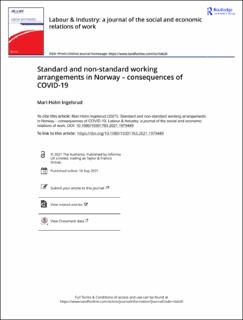| dc.contributor.author | Ingelsrud, Mari Holm | |
| dc.coverage.spatial | Norway | en_US |
| dc.date.accessioned | 2021-10-06T12:29:00Z | |
| dc.date.available | 2021-10-06T12:29:00Z | |
| dc.date.created | 2021-09-16T09:46:42Z | |
| dc.date.issued | 2021-09-16 | |
| dc.identifier.citation | Labour and Industry. 2021, 1-18. | en_US |
| dc.identifier.issn | 1030-1763 | |
| dc.identifier.issn | 2325-5676 | |
| dc.identifier.uri | https://hdl.handle.net/11250/2788151 | |
| dc.description.abstract | This study investigates how work-related consequences of COVID 19 in Norway during the first wave varied between workers in different employment arrangements. The generalised linear model (GLM) regressions estimate the relative risk of being directed to work from home, temporarily laid off, having reduced working time and income loss in a representative sample of 3002 workers. The models compare temporarily employed and self-employed workers with permanently employed workers and workers in voluntary and involuntary part-time positions with full-time workers. Results indicate that the self-employed had a higher likelihood of experiencing reduced working time and income loss. Temporary employment did not entail a higher likelihood of any measured outcomes. Part-time workers had a higher chance of income loss and a lower chance of being directed to work from home than full-time workers. Results also indicate that employees in part-time positions had a higher likelihood of having reduced working hours. The findings are discussed with perspectives on flexibility, risk and how standard jobs form regulation and welfare policy. Despite the government’s efforts to increase the safety nets for new groups of workers, our results indicate that the coverage was not wide enough. Thus, illustrating the individual economic risk inherent in non-standard employment relationships. | en_US |
| dc.description.sponsorship | This work was supported by the Norwegian Research Council [312716]. | en_US |
| dc.language.iso | eng | en_US |
| dc.publisher | Routledge | en_US |
| dc.relation.ispartofseries | Labour and Industry; | |
| dc.rights | Attribution-NonCommercial-NoDerivatives 4.0 Internasjonal | * |
| dc.rights.uri | http://creativecommons.org/licenses/by-nc-nd/4.0/deed.no | * |
| dc.subject | COVID-19 | en_US |
| dc.subject | Income losses | en_US |
| dc.subject | Non-standard employments | en_US |
| dc.subject | Norway | en_US |
| dc.subject | Temporary layoffs | en_US |
| dc.subject | Working-time reductions | en_US |
| dc.title | Standard and non-standard working arrangements in Norway – consequences of COVID-19 | en_US |
| dc.type | Peer reviewed | en_US |
| dc.type | Journal article | en_US |
| dc.description.version | publishedVersion | en_US |
| dc.rights.holder | © 2021 The Author(s). | en_US |
| cristin.ispublished | true | |
| cristin.fulltext | original | |
| cristin.qualitycode | 1 | |
| dc.identifier.doi | https://doi.org/10.1080/10301763.2021.1979449 | |
| dc.identifier.cristin | 1934775 | |
| dc.source.journal | Labour and Industry | en_US |
| dc.source.pagenumber | 1-18 | en_US |
| dc.relation.project | Norges forskningsråd: 312716 | en_US |

